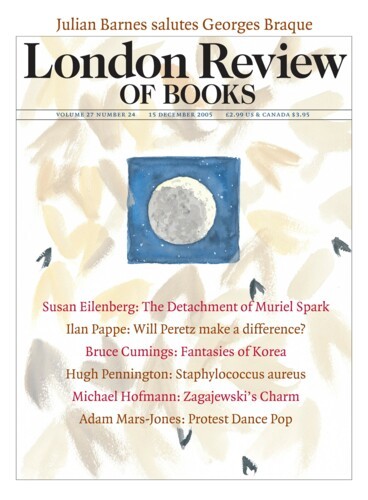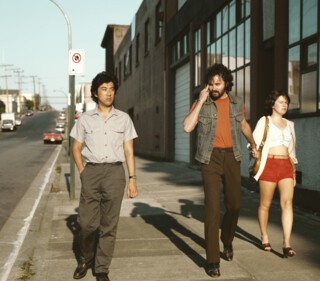Jeff Wall’s Mimic appears to be a documentary photograph. A tough man walks down the street, girlfriend in tow, and exchanges threatening glances with a passer-by. In Vancouver in 1982, when the picture was taken, it may have been more blindingly obvious that (as Wall relates it) the man’s reflexive gesture constituted racial abuse. Mimicry: a white trash white man mimics an Asian man’s eyes, repeating a gesture that lingers in the culture. But the picture is more dynamic than any interpretation can suggest. The men’s eyes have just ceased to meet, everybody is in motion, the empty street behind sinks away, the street sign points off in a different direction. The striking thing about the picture is not the message you choose to think it carries, but the arrested drama of a momentary charged encounter in a blank urban landscape.
Mimic, like the forty or so other photographs by Wall on show at Tate Modern until 8 January, is displayed in a large lightbox, backlit with an even brightness. The eeriness of the light adds to the sense of drama, as does the scale of the thing, such that the figures approach life-size and your eye plunges down to the clump of grass at the bottom left of the frame as though you too are involved in the scene. This is when you realise that the picture is impossible. If you’re so close to the action then the camera must have been too. There’s none of the foreshortened perspective that a sharp-shooting photojournalist’s telephoto lens would have brought: this photographer must have been right where we’re standing. He would have been involved. He was: Wall shot the picture with a large-format camera, using actors to reconstruct a moment he’d caught sight of on a Vancouver street, relocating his shoot to get the backdrop he needed, and arranging his set and his lighting to fabricate the look and feel of 1970s documentary cinema.
If there’s a clue to what’s going on here, it might be found in the job Wall got back in Canada after a stint at the Courtauld: he worked in a small movie theatre, checking the condition of the prints of old films – frame by frame. The effect of the exercise seems to have lasted: he learned how to divorce image from context and make it glow. Very few of his pictures make a show of their artifice, but it’s there if you look, and it’s never entirely erased. The large transparency sheets the photographs are printed on aren’t big enough for his purposes, and most of the pictures are made of two transparencies joined together: a black line where the sheets meet is sometimes visible in the lightbox as a single disrupting element. In The Destroyed Room (1978), which is all disruption, the line runs vertically down the middle. The room in question appears to have suffered a violent assault. An upturned bed has been gashed from corner to corner, a bamboo table has been torn apart, a chest of drawers has been ransacked and its contents strewn across the floor. The walls are red except where the plasterboard has been ripped away to reveal the pink fibreglass wool behind. Only a faux Degas statuette of a dancer stands undisturbed on top of the chest, a solitary survivor.
But it gradually becomes clear that there’s an order here. The composition follows a painting by Delacroix, The Death of Sardanapalus, and the objects descend from left to right in a broad abstract diagonal sweep. It’s also clear that this is a stage set: an open doorway reveals a white studio wall and a real window is visible through the fake one. It makes sense for an artist interested in the painterly possibilities of photography to want to boost a documentary-type image of urban squalor into the position of high art by injecting its composition with a bit of a pedigree. That much you expect, since several of the works have acknowledged models. What you don’t expect is that when you look closely at the details here they deny any possibility of disorder at all. A high-heeled shoe to the left is mirrored by one on the far right, two plastic pairs of kiddy sunglasses point in perpendicular directions, a red comb and a blue comb lie shelteringly together. The rips and tears in the fabrics and walls rhyme with one another: similar diagonals are magnified, translated and reproduced. Even the wooden struts that support the false room are positioned to form a diagonal cross. A version of Delacroix including multiple crosses: it’s as if Wall can’t allow himself to leave anything to chance.
He can’t: some of his pictures, as the exhibition’s accompanying texts are at pains to explain, take him many months to produce, the later ones constructed in Photoshop from a number of studied frames. He seems to be bedevilled by detail, and his pictures are full of tiny touches. Partly this is a product of his technique, the blown-up view seen in supernatural light that leaves no corner unexposed. But he isn’t Andreas Gursky, whose immensely detailed and faultless photographs use repeating patterns to create an endless flat surface. Wall is interested in overlooked corners and vertiginous perspectives, and in the spectral detail that you struggle to resolve. In his still lifes – An Octopus and Some Beans (both 1990) – it is the corroborating presence of the ball of fluff under the table that you look for to determine whether the pictures were shot at the same time in the same place. Wall seems to recognise his details as fetishes. Among his more disturbing arrangements is Odradek, Táboritská 8, Prague (1994), which shows a cheaply dressed girl descending a badly lit staircase, with a gaping opening to the left of the frame. It’s only after you’ve been reminded of Kafka by the writing on the gallery wall that you look under the stairwell to make out his version of Kafka’s creature Odradek lurking in the gloom: a tiny metal bobbin with a little foot that exactly matches the description in ‘The Cares of a Family Man’, so small and so dark as to be invisible in reproductions.
Wall says that the idea of the lightbox was suggested to him by the backlit advertising displays found in bus shelters and airports. This would lead you to think that he means to play with the exaggerated gestures and bright promises of the language of advertisement: a Warholian wallowing in mass reproduction. But his gestures are restrained and ambiguous, and the spaces his photography haunts are the in-between spaces of the modern city, places where the advert might catch you unawares. An open grave plummets to a view of sea urchins; an immigrant cleaner soaps a set of windows through which a rising statue is faintly visible, like a ghostly Botticelli. Wall’s bright lights illuminate dark corners, but you see as if through an occluding window that obscures as much as it reveals.
Send Letters To:
The Editor
London Review of Books,
28 Little Russell Street
London, WC1A 2HN
letters@lrb.co.uk
Please include name, address, and a telephone number.


